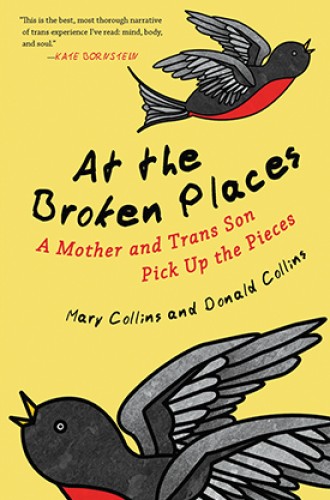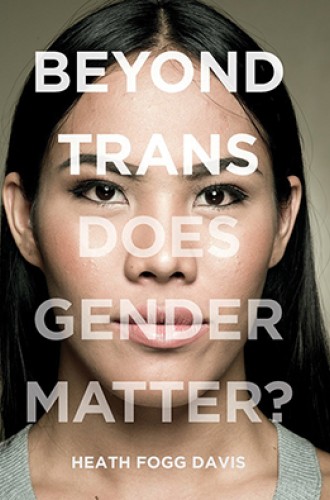A conversation in transition
Two new books help us talk about what it means to be transgender in a changing world.
As the parent of a transgender teen, I read with great interest these books about the issues transgender people face. Both books exemplify how to create conversations about gender that transcend divisive assumptions.
The painfully honest essays by Mary Collins and her son Donald lay bare the experiences of a concerned, skeptical parent and a struggling, transgender child. As a high school senior, Donald told his mother that he was transgender. Or perhaps that sentence should read (as Mary reports it) that Mary’s daughter told her she was transgender. The challenge of keeping the gender references straight in a book that spans a gender transition highlights the struggle to speak well and honestly when two people experience the same events differently.
Donald was discerned to be female at birth, was given a feminine name, and until high school presented as a girl. From Mary’s perspective, she had a daughter who transitioned against her mother’s will to become a transgender son. From Donald’s perspective, he was only ever a “daughter” (he uses scare quotes to designate his natal gender), and he speaks not of a transition so much as a process of his gender becoming physically and personally more congruent.
It is a story of conflict, misunderstanding, anger, and grief. Mary observes, “Much of [the transition] had not gone well; indeed, it nearly broke us as a family.” Donald adds, “It’s horrifying when something that gives you great fulfillment has the exact opposite effect on someone you care about.” But amid the discord is a love that won’t go away and a desire to understand that finally brings not agreement but rapprochement and relationship.
The presence of two distinct perspectives keeps this book from being simply a work of advocacy for one side or another. Mary and Donald are models for those wishing to reach across the divide of this cultural battlefield. Yet I wished at times for a closer connection between the mother and son essays, which read as separate reflections on a common topic. For instance, at one point Donald suggests that his mother’s concerns had to do with her Catholic upbringing: “Many of my mother’s fears seemed to come from a deeply Christian place. She told me, on more than one occasion, that to undergo hormone treatment and surgery would be unnatural, against God in some way.” Yet Mary never addresses religion in her essays.
One of the great strengths of the book is Mary’s reflection on grief, which for the parents of transgender children is particularly fraught. Even the most accepting parents discover that there is no avoiding the grief of having to let go of the picture they had of their child and the future they had imagined. Further, parent and child inevitably struggle to negotiate and speak of their memories of the past. Mary describes poignantly the pain of trying to hold on to her experience of Donald’s “girlhood” while Donald was pursuing health and wholeness precisely by rejecting and reinterpreting that childhood in radical ways. Mary writes, “As a transgender man, Donald has a right to actualize his own identity. As a mother, I also have a right to remember and cherish my baby girl. Those two lines can fit into the same paragraph and not destroy each other.”
The book largely succeeds in reaching the goal articulated by Mary:
What we need is a third way to talk about gender issues, dialogue that is not so polarizing but more in line with what really happens when people slip along the gender slide rule. Instead of asking if gender nonconformity is right or wrong, we could be discussing what it is, what it means, and how much pain it can cause for the person in transition and those who love that person.
This reference to the “gender slide rule” alludes to the reality that there are multiple ways of existing outside of gender norms in addition to being transgender. Intersex people, for instance, are born with physiological, chromosomal, or hormonal traits that do not fit clearly within a male or female designation. Others identify as genderqueer, gender-fluid, or gender-nonconforming, meaning they seek not to find a stable place within the male-female binary but rather to stretch gender categories.
Given the gender slide rule, Heath Fogg Davis questions the role gender identification plays in institutional contexts. He argues that mainstream liberal activists have too often been satisfied with assimilation and accommodation—seeking to make it easier for transgender people to assimilate to their discerned gender identity and be accommodated within the binary options made available. This strategy, he argues, downplays the public policing of gender of those who do not present in a way that easily registers as male or female.
Davis, who is transgender, contends that minimizing the instances in which gender is used to mark identity or segregate experiences will “make both transgender and gender-nonconforming individuals and the cisgender majority better off at the same time” (although he gives only passing attention to the benefits for the cisgender majority).
His central argument is that organizations should apply the “rational relationship test” to policies that involve marking and managing sex identity. The test “asks whether a given policy is ‘rationally related’ to a legitimate policy goal. In layperson’s terms, this means asking whether a given sex-classification policy is harmful, and whether it is necessary.” It means, further, asking if “the use of sex classification [could] be replaced by some alternative policy that is rationally and perhaps more tightly connected to specific legitimate policy goals.”
Davis applies this test to four case studies: gender markers on government documents, sex-segregated public bathrooms, single-sex education, and sex-segregated sports. He then provides tools for organizations to conduct their own “gender audits.”
Davis’s aim is to teach readers to discern when sex identification and segregation are relevant to organizational goals and when they are the product of routinized classification that harms and excludes for no vital or legitimate purpose. Readers may not agree with all of Davis’s conclusions, but his method of discerning rational relationships provides a helpful way to create conversations about whether a particular instance of sex segregation is legitimate or problematic. It encourages us to become far more reflective about when and why we believe sex needs to be marked and managed. This is especially true for those of us who aim to be “LGBT friendly.”
The book does not address churches or religious institutions directly. I’m intrigued by the idea of conducting gender audits in churches and church-related institutions. How do we mark out gender difference in church and why? Is there a rational relationship between ecclesial goals and practices of gender sorting—say, when we divide singing into men’s and women’s parts, alternate reading a psalm between men and women, or hold separate women’s and men’s retreats? Davis’s work does not suggest that all these instances of gender sorting are harmful, but he challenges us to ask what good we believe we are achieving and what implicit messages we might be sending that are counter to our convictions. Do we think there are “male” and “female” ways to follow Jesus?
Both of these books contribute significantly to the growing conversation about transgender issues by modeling how to remain open to voices that are skeptical, concerned, or undecided about the transformation occurring in our culture. “Sometimes when we celebrate openness for a marginalized group, we wind up marginalizing someone else,” writes Mary Collins. “We have few positive avenues for honest conversation. Everyone digs in with hard-and-fast points of view and shows little respect for the other side.”
Whether it’s a parent trying to understand a child or an organization examining the effects of its decisions on gender-nonconforming individuals, a willingness to explore the terrain from other people’s perspectives may lead to compromise and relationship, even if not always agreement.
A version of this article appears in the January 3 print edition under the title “A conversation in transition.”







